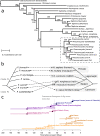Genomic insights into the host specific adaptation of the Pneumocystis genus
- PMID: 33686174
- PMCID: PMC7940399
- DOI: 10.1038/s42003-021-01799-7
Genomic insights into the host specific adaptation of the Pneumocystis genus
Abstract
Pneumocystis jirovecii, the fungal agent of human Pneumocystis pneumonia, is closely related to macaque Pneumocystis. Little is known about other Pneumocystis species in distantly related mammals, none of which are capable of establishing infection in humans. The molecular basis of host specificity in Pneumocystis remains unknown as experiments are limited due to an inability to culture any species in vitro. To explore Pneumocystis evolutionary adaptations, we have sequenced the genomes of species infecting macaques, rabbits, dogs and rats and compared them to available genomes of species infecting humans, mice and rats. Complete whole genome sequence data enables analysis and robust phylogeny, identification of important genetic features of the host adaptation, and estimation of speciation timing relative to the rise of their mammalian hosts. Our data reveals insights into the evolution of P. jirovecii, the sole member of the genus able to infect humans.
Conflict of interest statement
The authors declare no competing interests.
Figures






Similar articles
-
Retracing the evolution of Pneumocystis species, with a focus on the human pathogen Pneumocystis jirovecii.Microbiol Mol Biol Rev. 2024 Jun 27;88(2):e0020222. doi: 10.1128/mmbr.00202-22. Epub 2024 Apr 8. Microbiol Mol Biol Rev. 2024. PMID: 38587383 Free PMC article. Review.
-
Pneumocystis jirovecii.Trends Microbiol. 2020 Dec;28(12):1034-1035. doi: 10.1016/j.tim.2020.03.006. Epub 2020 Apr 21. Trends Microbiol. 2020. PMID: 33171104 No abstract available.
-
Sterol biosynthesis and sterol uptake in the fungal pathogen Pneumocystis carinii.FEMS Microbiol Lett. 2010 Oct;311(1):1-9. doi: 10.1111/j.1574-6968.2010.02007.x. FEMS Microbiol Lett. 2010. PMID: 20528942 Review.
-
Pneumocystis oryctolagi sp. nov., an uncultured fungus causing pneumonia in rabbits at weaning: review of current knowledge, and description of a new taxon on genotypic, phylogenetic and phenotypic bases.FEMS Microbiol Rev. 2006 Nov;30(6):853-71. doi: 10.1111/j.1574-6976.2006.00037.x. FEMS Microbiol Rev. 2006. PMID: 17064284 Review.
-
Pneumocystis jirovecii Rtt109, a novel drug target for Pneumocystis pneumonia in immunosuppressed humans.Antimicrob Agents Chemother. 2014 Jul;58(7):3650-9. doi: 10.1128/AAC.02637-14. Epub 2014 Apr 14. Antimicrob Agents Chemother. 2014. PMID: 24733475 Free PMC article.
Cited by
-
Axenic Long-Term Cultivation of Pneumocystis jirovecii.J Fungi (Basel). 2023 Sep 1;9(9):903. doi: 10.3390/jof9090903. J Fungi (Basel). 2023. PMID: 37755011 Free PMC article.
-
Development of Highly Efficient Universal Pneumocystis Primers and Their Application in Investigating the Prevalence and Genetic Diversity of Pneumocystis in Wild Hares and Rabbits.J Fungi (Basel). 2024 May 15;10(5):355. doi: 10.3390/jof10050355. J Fungi (Basel). 2024. PMID: 38786710 Free PMC article.
-
Metabolic modelling as a powerful tool to identify critical components of Pneumocystis growth medium.PLoS Comput Biol. 2024 Oct 28;20(10):e1012545. doi: 10.1371/journal.pcbi.1012545. eCollection 2024 Oct. PLoS Comput Biol. 2024. PMID: 39466836 Free PMC article.
-
Meta-Analysis and Systematic Literature Review of the Genus Pneumocystis in Pet, Farm, Zoo, and Wild Mammal Species.J Fungi (Basel). 2023 Nov 4;9(11):1081. doi: 10.3390/jof9111081. J Fungi (Basel). 2023. PMID: 37998885 Free PMC article.
-
Comparative genomics of Cryptococcus and Kwoniella reveals pathogenesis evolution and contrasting karyotype dynamics via intercentromeric recombination or chromosome fusion.bioRxiv [Preprint]. 2024 Jan 13:2023.12.27.573464. doi: 10.1101/2023.12.27.573464. bioRxiv. 2024. Update in: PLoS Biol. 2024 Jun 6;22(6):e3002682. doi: 10.1371/journal.pbio.3002682. PMID: 38234769 Free PMC article. Updated. Preprint.
References
Publication types
MeSH terms
Substances
Grants and funding
LinkOut - more resources
Full Text Sources
Other Literature Sources
Molecular Biology Databases

